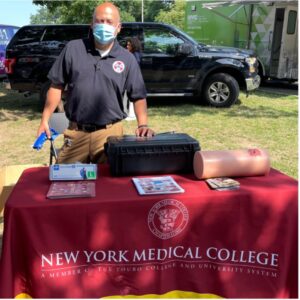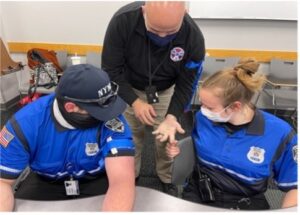
During a time when there is a large focus on public health emergencies such as COVID-19 and Monkeypox, it is important to remember that other disasters and emergencies still occur worldwide. Everyone needs to be prepared by taking Skills Training Group’s first aid courses so that they can aid at a moment’s notice until emergency responders arrive. We have seen too many tragic incidents such as mass shootings and other events where people have been injured or killed.
New York Medical College’s (NYMC) Center for Disaster Medicine (CDM) believes in educating and raising the awareness level of all community members. The CDM, founded in 2005, conducts interdisciplinary research, training, technical assistance and educational activities related to emergency preparedness for disasters, terrorism and public health emergencies. The CDM is equipped to train members from different sectors including public safety, health care and education and as well as the general public. By training first responders and focusing on vulnerable populations, including children, the disabled and the elderly, the Center fulfills a unique role in the region by serving as a multi-disciplinary academic resource on various emergency preparedness issues. Whether augmenting academic preparation through an advanced certificate in emergency management program or providing hands-on training to anyone interested in being better prepared, the CDM is up to the challenge of teaching life-saving skills.
Recently, the CDM has been focused on providing STOP THE BLEED training throughout Westchester County. Launched in 2015, STOP THE BLEED is a national campaign sponsored by the White House and is offered in more than 134 countries. As of May 2022, there are more than 100,000 certified instructors and more than 2.1 million people trained. The training focuses on what a person can do to prevent excessive bleeding from an injury resulting from a motor vehicle collision, intentional/accidental injury or a disaster. The basic steps of STOP THE BLEED are to:
- Put direct pressure on the wound
- Pack the wound
- Properly place a tourniquet above the wound site

The STOP THE BLEED course, which is offered in English and Spanish, takes approximately one hour and involves a brief lecture plus hands-on practical skills training. The CDM currently offers this free training to any organization or group from the public. The CDM has already conducted this essential training for local police departments, fire departments, emergency medical services, boy scouts and other community-based groups. It is never too late to get more education or training to be prepared.
September is National Preparedness Month across the United States. The Center is pleased to make its staff available to offer STOP THE BLEED training upon request. Take advantage of this important opportunity to learn valuable information and skills to prepare for the next emergency.
For more information on the Center for Disaster Medicine at New York Medical College, please visit www.nymc.edu/disastermed. For more information or to schedule a STOP THE BLEED class, please email disaster_medicine@nymc.edu.
George W. Contreras, M.P.H., M.S., MEP, CEM, FAcEM, EMTP, is assistant director for the Center for Disaster Medicine, and assistant professor in the Institute of Public Health at New York Medical College. He is adjunct associate professor at John Jay College of Criminal Justice and adjunct professor at Metropolitan College of New York. He works on the front lines as a paramedic in New York City and possesses more than thirty years of experience in the fields of emergency medical services, public health, emergency management, humanitarian response, training, education, and consulting at the national and international level.






